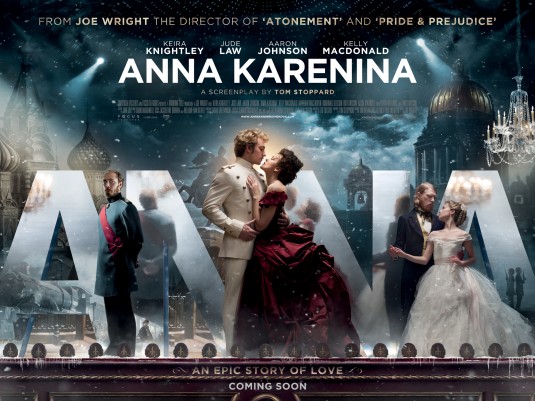Love. Betrayal. Scandal. Devastation. No, I’m not talking about the Petraeus affair. It’s time to dust off your high school classics and delve into Anna Karenina…or for some of you, time to get acquainted. It’s not note-by-note faithful to the Tolstoy classic, but this film’s wonderful blend of traditional storytelling and avant garde filmmaking captures your attention and holds it fast. Not a bad trick for a movie that’s over two hours long.
Here’s the Cliff Notes version; lovely, spirited Anna is married to a dull bureaucrat. But her heart gets a kick-start when she meets the dashing young Count Vronsky. However, their love is forbidden, as she’s already hitched; Russian high society won’t stand for that sort of rule breaking. It’s all kindsa Russian Downton Abbey up in here — even Lady Mary (Michelle Dockery, as Princess Myagkaya) makes an appearance!
What you’ll notice first off is the setting. Yes, the story takes place in Russia and there’s plenty of pre-revolution sumptuousness. But director Joe Wright (Atonement) takes a leap into experimental territory by setting the bulk of the story in an old grand theater. From the opening scene where the curtain rises on Prince Oblonsky getting a shave — with only the actors and a barber’s chair onstage — to the final scene of Karenin sitting in a field of flowers that spill over into the theater, this is definitely not a cold retelling. The theater setting is not a contrivance, but a jumping-off point to illustrate the sumptuousness of the Russian Imperial Court at the time this story is set, and lends itself well to the feeling of intrigue and passion. And don’t worry, this film isn’t so into it’s own uniqueness that it’s impossible to follow; think of the theater setting as a touch of indie that livens up a classic tale.
And liven it up it does. The art direction in Anna Karenina is top-notch, with beautifully detailed sets, wonderfully done cinematography and photography, as well as breathtaking costuming that had me longing to dash through snowy Russian winters wrapped in gorgeous silks and (faux) furs. It may suck to be an anathema in your social circles, but that doesn’t mean you can’t look fabulous.
The performances keep up with their surroundings. Keira Knightley, who worked with Wright on Atonement and 2005’s Pride and Prejudice, is obviously comfortable working with the director, and gives a glorious, multi-layered performance. You understand her longing for passion, all the while condemning her for destroying her life so totally. Matthew Macfadyen (Knightley’s Mr. Darcy in Pride and Prejudice) gives great joie de vivre as Anna’s brother Prince Oblonsky, a man who loves his wife but is also a consummate womanizer; everything wrong with the aristocracy, but Macfadyen brings a touch of loveable scamp to the role. Aaron Taylor-Johnson is a perfect Vronsky, all model-boy charm and flash, but there are times when passion and hopelessness crack the beautiful facade.
Then there’s the man who got the short end of the stick, Karenin (Anna’s name, Karenina, is a feminine version of her husband’s. A bit confusing, yes, but it’s easy enough to catch on.) In high school I rooted for Anna, heartbroken that her love came to such tragedy. Now? I feel more for the ever-loving husband. And that’s because in this version of Anna Karenina, Jude Law’s Karenin is a long-suffering man who loves Anna so completely and utterly that he trusts her completely and becomes a shell when she’s gone. It’s a far cry from the cold, going-through-the-motions man from Tolstoy’s pages. I found myself rooting for Karenin, hoping Anna would see how much he loved her. Now that’s something I never did back in the day.
Did screenwriter Tom Stoppard (Shakespeare In Love) and director Wright play fast & loose with the basic story? Absolutely. But it’s still an affecting film, and the good, solid bones of the tale are definitely in place. For those of you who are fans of Levin’s story — a tale that is a sort of parallel reflection of Anna’s in the novel — he and his love Kitty are here. This Anna Karenina focuses mainly on their love story, but there are nods to the themes of faith, agriculture, progress, religion and politics woven throughout.
Ice and snow, hot passions and fiery vodka. Glittering jewels and razor-sharp gossip. Anna Karenina has got it all and then some. For purists, this film may stir up some bad blood. But for those looking for an epic tale with a dash of indie film spice, this fits the bill perfectly.


Leave a Reply